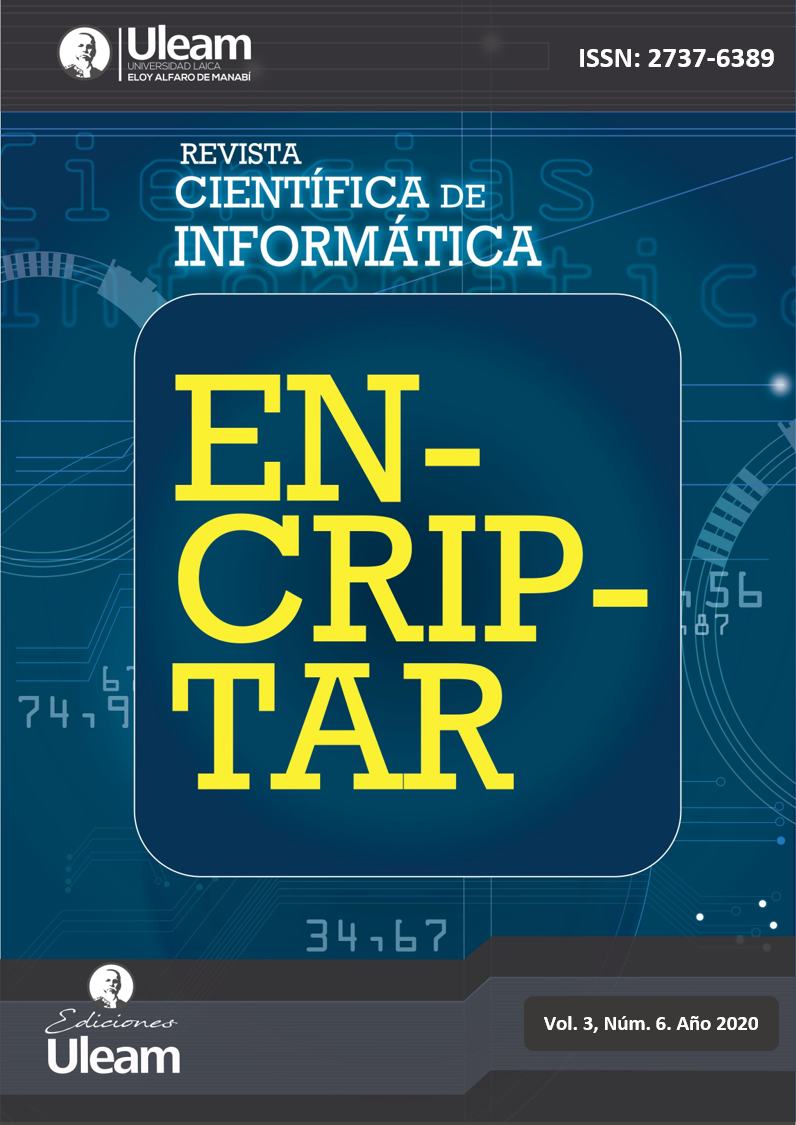Impact of Child Grooming on students in the educational units of the city of Calceta
Keywords:
Cyberbullying, risk, social networks, false profiles, harassment, sexualAbstract
Child Grooming is defined as the harassment of a minor by an adult for sexual purposes, generally through social networks. The purpose of this research was to determine the risk level of Child Grooming in first, second and third year high school students of the Educational Unit October 13 of the city of Calceta during the school year 2020 - 2021. For the elaboration of the survey asked a total of 14 questions related to this type of harassment. The methodology that was applied was in three phases: 1. Classification of the questions by high, medium and low risk level; 2. Statistical analysis where stratified sampling was used with a total of 185 students, out of a population of 580; and finally the data analysis was carried out. The results show that the rate of students who could suffer from cyberbullying is relatively high according to the survey carried out, since through it it was analyzed that there are a large number of students who have conversations with strangers through social networks and that also a high percentage of these falls on the female sex. It is concluded that the use of social networks without the proper control of an adult, makes young people involuntarily establish friendship with people who create false profiles and share photos until the offender achieves his goal.
Keywords: Cyberbullying, risk, social networks, false profiles, harassment, sexual.
Downloads
References
Arias M, Buendía L, F. F. (2018). Grooming, Ciberbullying y Sexting en estudiantes en Chile según sexo y tipo de administración escolar. Revista Chilena de Pediatría, 89. https://doi.org/http://dx.doi.org/10.4067/S0370-41062018005000201
Bringas M. Novo M. (2017). Psícologia Jurídica Conocimeinto y Práctica. Facultad de Derecho, Universidad de Sevilla. Colección Psicología y Ley, No 14, (Sociedad Española de Psicología Jurídica y Forense).
Candra, S., Gunawan, F. E., Ashianti, L., & Soewito, B. (2019). Detecting Online Child Grooming Conversation. (June 2018). https://doi.org/10.12928/TELKOMNIKA.v16i3.6745
El Telégrafo. (2017). El grooming amenaza a los menores que utilizan las redes sociales. Retrieved from https://www.eltelegrafo.com.ec/noticias/septimo/51/el-grooming-amenaza-a-los-menores-que-utilizan-las-redes-sociales
Eurostat. (2019). Estadísticas de economía digital y sociedad digital a nivel regional. https: // ec. europa.eu/eurostat/statistics-explained/index.php/Eurostat_regional_yearbook.
Fiscalía General del Estado. (2020). Child Grooming o Ciberacoso con finalidad sexual: Revista perfil criminológico, p.6.
Ghezzi. M, (2020). Ciberacoso a niños y Adolescentes (GROOMING): pp.13-14. http://repositorio.upch.edu.pe/bitstream/handle/upch/8425/Ciberacoso_MarquinaGhezzi_Vania.pdf?sequence=1&isAllowed=y
González L. Hernández N. (2017). Menores y redes sociales: los riesgos de un mal uso. Retrieved from https://riull.ull.es/xmlui/bitstream/handle/915/6893/Menores y redes sociales los riesgos de un mal uso.pdf?sequence=1
Loaiza Y. (2019). El disfraz pederasta. Retrieved from https://gk.city/2019/07/01/grooming-ecuador-pederastia/
Observatorio de la Seguridad de información. (INTECO, 2012). hábitos seguros en el uso de las TIC por niños y adolescentes y e-confianza de sus padres: guía de actuación sobre el Ciberacoso, (p.25). https://www.is4k.es/sites/default/files/contenidos/herramientas/guia_ciberacoso.pdf
Panizo V. (2011). El ciber-acoso con intención sexual y el child-grooming. Quadernos de Criminología: Revista de Criminología y Ciencias Forenses, 22–33.
Santisteban P. Gómez-Guadix M. (2017). Estrategias de persuasión en grooming online de menores: un análisis cualitativo con agresores en prisión. Psychosocial Intervention, 26(1), 139–146. https://doi.org/10.1016/j.psi.2015.07.007
Santonja J. (2019). Análisis y correlación entre probabilidad e impacto de los riesgos.
Vuanello G. (2015). Los niños frente a Internet: seguridad, educación y tecnología. Trayectorias, 17, 108–129.
Schoeps, K., Hernández, M. P., Garaigordobil, M., & Montoya-Castilla, I. (2020). Risk factors for being a victim of online grooming in adolescents. Psicothema, 32(1). https://doi.org/10.7334/psicothema2019.179
Published
How to Cite
Issue
Section
License
Copyright (c) 2021 Scientific Journal of Informatics ENCRYPT - ISSN: 2737-6389.

This work is licensed under a Creative Commons Attribution-NonCommercial-ShareAlike 4.0 International License.















